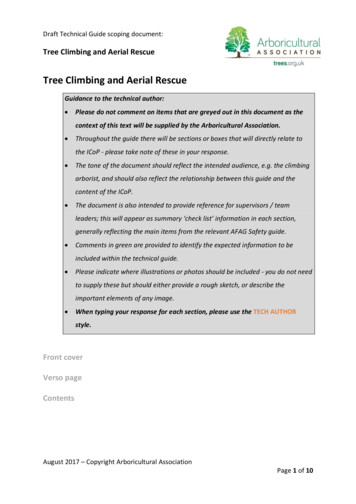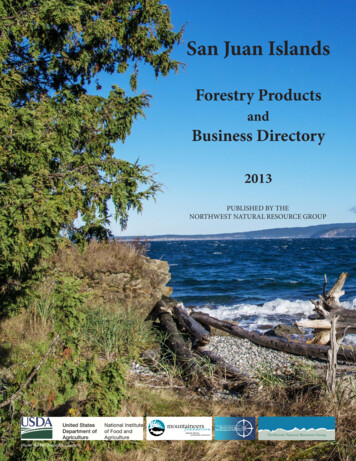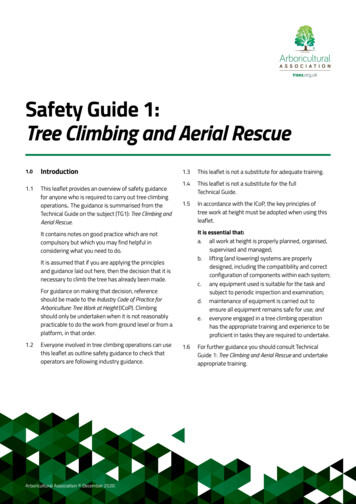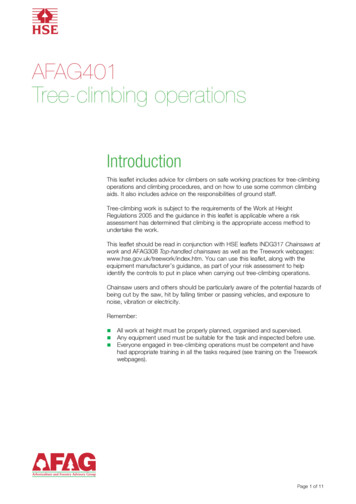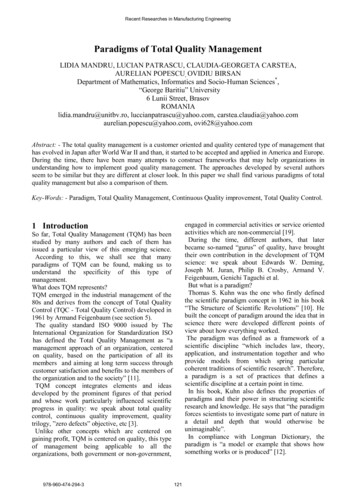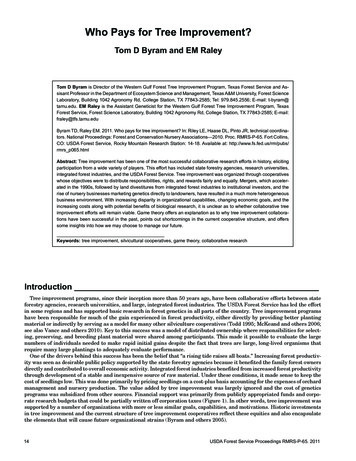
Transcription
Who Pays for Tree Improvement?Tom D Byram and EM RaleyTom D Byram is Director of the Western Gulf Forest Tree Improvement Program, Texas Forest Service and Assisant Professor in the Department of Ecosystem Science and Management, Texas A&M University, Forest ScienceLaboratory, Building 1042 Agronomy Rd, College Station, TX 77843-2585; Tel: 979.845.2556; E-mail: t-byram@tamu.edu. EM Raley is the Assistant Geneticist for the Western Gulf Forest Tree Improvement Program, TexasForest Service, Forest Science Laboratory, Building 1042 Agronomy Rd, College Station, TX 77843-2585; E-mail:fraley@tfs.tamu.eduByram TD, Raley EM. 2011. Who pays for tree improvement? In: Riley LE, Haase DL, Pinto JR, technical coordinators. National Proceedings: Forest and Conservation Nursery Associations—2010. Proc. RMRS-P-65. Fort Collins,CO: USDA Forest Service, Rocky Mountain Research Station: 14-18. Available at: http://www.fs.fed.us/rm/pubs/rmrs p065.htmlAbstract: Tree improvement has been one of the most successful collaborative research efforts in history, elicitingparticipation from a wide variety of players. This effort has included state forestry agencies, research universities,integrated forest industries, and the USDA Forest Service. Tree improvement was organized through cooperativeswhose objectives were to distribute responsibilities, rights, and rewards fairly and equally. Mergers, which accelerated in the 1990s, followed by land divestitures from integrated forest industries to institutional investors, and therise of nursery businesses marketing genetics directly to landowners, have resulted in a much more heterogeneousbusiness environment. With increasing disparity in organizational capabilities, changing economic goals, and theincreasing costs along with potential benefits of biological research, it is unclear as to whether collaborative treeimprovement efforts will remain viable. Game theory offers an explanation as to why tree improvement collaborations have been successful in the past, points out shortcomings in the current cooperative structure, and offerssome insights into how we may choose to manage our future.Keywords: tree improvement, silvicultural cooperatives, game theory, collaborative researchIntroductionTree improvement programs, since their inception more than 50 years ago, have been collaborative efforts between stateforestry agencies, research universities, and large, integrated forest industries. The USDA Forest Service has led the effortin some regions and has supported basic research in forest genetics in all parts of the country. Tree improvement programshave been responsible for much of the gain experienced in forest productivity, either directly by providing better plantingmaterial or indirectly by serving as a model for many other silviculture cooperatives (Todd 1995; McKeand and others 2006;see also Vance and others 2010). Key to this success was a model of distributed ownership where responsibilities for selecting, preserving, and breeding plant material were shared among participants. This made it possible to evaluate the largenumbers of individuals needed to make rapid initial gains despite the fact that trees are large, long-lived organisms thatrequire many large plantings to adequately evaluate performance.One of the drivers behind this success has been the belief that “a rising tide raises all boats.” Increasing forest productivity was seen as desirable public policy supported by the state forestry agencies because it benefited the family forest ownersdirectly and contributed to overall economic activity. Integrated forest industries benefited from increased forest productivitythrough development of a stable and inexpensive source of raw material. Under these conditions, it made sense to keep thecost of seedlings low. This was done primarily by pricing seedlings on a cost-plus basis accounting for the expenses of orchardmanagement and nursery production. The value added by tree improvement was largely ignored and the cost of geneticsprograms was subsidized from other sources. Financial support was primarily from publicly appropriated funds and corporate research budgets that could be partially written off corporation taxes (Figure 1). In other words, tree improvement wassupported by a number of organizations with more or less similar goals, capabilities, and motivations. Historic investmentsin tree improvement and the current structure of tree improvement cooperatives reflect these equities and also encapsulatethe elements that will cause future organizational strains (Byram and others 2005).14USDA Forest Service Proceedings RMRS-P-65. 2011
Who Pays for Tree Improvement?Figure 1. In-kind support for southern pine tree improvement (in millions of US dollars) from a 2007 survey of the members of the NorthCarolina State University Cooperative Tree Improvement Program, theCooperative Forest Genetics Research Program, University of Floridaand the Western Gulf Forest Tree Improvement Program (McKeandand others 2007).What Prevents Us from Using theSame Highly Successful ModelGoing Forward?The ugly truth is that while making the best geneticswidely available may make good public policy, it also makesgenetics a low-value commodity from which it is difficult tomake a direct profit. This situation is not unique to foresttrees but is a problem shared by all minor crops, many thathave breeding programs supported primarily by the public(Berland and Lewontin 1986). This constraint has actually been less problematic in forest industry than in otherbreeding programs for at least two reasons. First, the costof tree improvement, including in-kind contributions, hasbeen relatively modest given the value of the crop. Second,and more importantly, most participants in forest genetics programs made their profits with their manufacturingfacilities, not from the sale of genetic improvement, wheremost seed companies make their incomes.Mergers among integrated forest companies, that rapidlyaccelerated during the 1990s, were followed closely by thedivestment of corporate forest land to institutional investors. This resulted in a reduction in the number of playersthat could logically participate in breeding programs; theseprograms benefit from the economies of scale. Concurrently,several state agencies adopted the position that economicdevelopment should be left to the private sector, and haveclosed tree improvement programs, abandoned orchards,and shuttered nurseries. Furthermore, the new class oflarge institutional forestland investor/owners frequentlyhas different investment criteria than those historicallyUSDA Forest Service Proceedings RMRS-P-65. 2011Byram and Raleyheld by integrated forest industry. Some have recognizedthat they have a vested interest in forest productivity toreduce the cost of their own production and to maintain aviable manufacturing customer base. These organizationshave been both aggressive and innovative in maintainingtheir commitment to tree improvement programs. Otherinstitutional owners, representing a sizeable proportion ofthe landbase previously supporting tree improvement programs, have opted to buy seedlings on the open market andessentially forego the in-kind cost of tree improvement. Thisis a completely rational decision where fragmented ownership reduces the size of holdings within any one breedingand deployment zone below the level needed to support astand-alone tree improvement program.Concurrent to the withdrawal of state forestry agenciesfrom seedling production and the rise of a new base ofcustomers, a stand-alone forest tree nursery business hasarisen. This was made possible, in part, by the divestitureof land by forest industry. As some organizations no longerhad an internal need for seeds, the consequence was thatthe best genetics from existing orchards have become morewidely available. These new ventures market a wider rangeof genetics than previously available, but must make theirprofit on the sale of seedlings rather than higher valuestumpage. Strategies for a nursery business can includeselling a low cost commodity where there is little incentiveto develop new products. Alternatively, market differentiation can be developed by selling full-sib families, varietallines, or seedlings that differ genetically from other sourceson the market. These seedlings offer good genetic value tothe customer. Unless the market recognizes their economicvalue, there will be little incentive to invest in the futureof tree improvement. Market differentiation can also driveincreased competition. As tree improvement is primarilya pre-commercial population development program, thisneed not limit collaboration and, in fact, sharing the costof development could be an incentive for more intensivecooperation.Tree improvement is now poised to make remarkablegains. Swift progress is occurring in vegetative propagation,selection efficiencies, and deployment strategies. Substantialinvestments are occurring in silviculture research (Vanceand others 2010) and basic genetics (Whetten and Kellison2010) that can make our forest potentially far more productive. The USDA National Institute of Food and Agriculture(NIFA) is making very large investments in basic research andproof-of-concept type experiments (NIFA 2010a, 2010b); theresults from this government- sponsored research, however,will have to be translated into operational programs throughapplied breeding programs. As a consequence, future treeimprovement programs will require community resourcesfar beyond what has been considered normal in the past(Table 1). In addition, it is likely that it will be desirable tomeasure attributes such as BTU content or nanostructurereactivity that will involve investments in new equipmentor the development of service laboratories (Briggs 2010;Wegner and others 2010). These factors offer tremendousopportunities to improve productivity and to develop novelproducts, but they will come at an increased cost and complexity that we have not yet incorporated into our currentsystem.15
Byram and RaleyWho Pays for Tree Improvement?Table 1. Infrastructure that may be needed to support a modern tree breedingprogram.Germplasm Conservation Scion banks and long-term seed storageDNA Stock CenterscDNA librariesBAC librariesPCR primer setsResearch PopulationsAssociation and mapping populations beyond standard progeny testing(crossing, establishing, maintaining, and measurements)Specialized Skills in BiometricsLaboratory Facilities for PhenotypingWood densityMicrofibril angleBTU contentFermentation /conversion efficiencyNanocrystalsNanostructure reactivityComplexity comes in many forms, but probably the mostchallenging to the current structure will be the need tomanage intellectual property. In theory, this can be doneby assigning responsibilities, rights, and rewards according to each organization’s contribution. Tree improvementprograms have been extremely successful over the past 50years, working with handshake agreements as these threefactors have been more or less equally shared. It seemsunlikely that this structure will be successful going forwardas organizational capacities and goals diverge.What Can Game Theory Teach Usabout Tree Improvement?These substantial organizational difficulties can be overcome. Game Theory, the study of how individuals interact andorganize (see for example Myerson 1991), offers an explanation as to why tree improvement collaborations have beensuccessful in the past, points out shortcomings in the currentcooperative structure, and offers some insights into how wemay choose to manage our future. Briefly, collaborationsdevelop when the benefits to the participants exceed whatthey can expect from acting as individuals. In other words,individuals will work together when the whole is greaterthan the sum of the parts. This has certainly been true intree improvement programs where population developmentis primarily a pre-commercial development program thatbenefits directly from economies of scale. In Game Theoryterminology, shortly after collaboration develops, “cheatersand freeloaders” emerge that reap the benefits of the collaboration without contributing to the group. The systemconveys a competitive advantage to them, so their decisionis completely justified from an individual’s perspective. Theiremergence within the system is inevitable and unavoidable.Collaborations can tolerate some level of defection, whichagain reflects conditions in tree improvement’s past. For16example, nurseries operated by integrated forest industriescould afford to subsidize seedlings for outside sales becausethis reduced the per-unit cost of seedlings used internally.When the motivation to “cheat or freeload” reaches a criticallevel, however, one of two things will happen. Collaborationscollapse and a competitive environment predominates, ormethods are found to promote continued teamwork throughincentives and/or punishments applied to limit defectors. Animportant corollary is that collaboration is not always thebest option. When development of a product is anticipatedto be costly and economically risky, the prospect of havinga competitive advantage is frequently a necessary motivation for making the required investment. Examples fromour industry include the development of varietal lines andgenetically modified trees. A second corollary is that enforcement of collaboration in the face of increasing pressures todefect comes at a cost to the partnering organizations. Thisis frequently in the form of increased complexity, lack ofindividual flexibility, or increased operating expenses.Therefore, according to Game Theory, three conditionsmust be met for continued collaborative tree improvementefforts to be warranted: 1) net benefits of collaboration mustexceed those of competition; 2) benefits must also exceed thecost of enforcement against defectors; and 3) participantsmust perceive that responsibilities, rights, and rewards arefairly distributed. Condition 1 will be true as long as population improvement is deemed a priority because very largebreeding programs are out of reach of single organizations.In fact, the opportunity cost in allowing collaboration to atrophy would be substantial if the comparison to corn yieldsis accurate (Figure 2). Conditions 2 and 3 can be met withappropriate organizational structure that fairly distributescosts and manages intellectual property. If done properly, thiswould encourage investment from landowners and investorswith a vested interest in improved forest productivity thatcurrently opt out of directly supporting tree improvementresearch.USDA Forest Service Proceedings RMRS-P-65. 2011
Who Pays for Tree Improvement?Byram and RaleyFigure 2. Estimated progress of forest tree breeding from realized gain and number of generations in the breeding program compared to the actual US corn yields reflecting the applicationof modern breeding programs (corn yields from Ruttan 1999).Other crops have done this by collecting a mandatorycheck-off fee at the point of sale that is then used to supportresearch (for example, the Cotton Board and the NationalPeanut Board). This system supports university researchthat supplies breeding stock to seed companies who in turnsell seeds to farmers. An analogous system in forestry wouldbe the collection of a check-off fee at the mill gate based ondelivered tonnage. The cost of tree improvement would thenbe paid by the landowner and/or manufacturer who arguably benefit most directly from investments in productivityimprovement. This solution, however, is extremely unlikelyfor forestry as it would require legislation.ConclusionsForestry could follow another structure made possiblebecause our production model is somewhat different. Weare simultaneously the research arm, the seed company,and in many cases, also the farmer. A breeders associationcould raise funds based on a voluntary metric, such as theamount of outside seedling sales, and redistribute this incometo support breeding and progeny testing and the necessarycommunity resources listed in Table 1. Regardless of themodel the forestry community ultimately chooses, we believeit should incorporate the following elements:1. Those that benefit from tree improvement should payfor it. While the ultimate beneficiary is the consumerand the society to which he/she belongs, this is toonebulous to be practical. The points in the value chainwhere money changes hands determine the logicalplaces where value can be captured. Possible links inthe value chain are: 1) sale of seeds; 2) sale of seedlings;3) sale of stumpage; 4) sale of a manufactured product;or 5) taxes raised due to increased economic activity.USDA Forest Service Proceedings RMRS-P-65. 20112. Additional funds over and above the in-kind support currently provided by the participants in tree improvementcooperatives (Figure 1) must be generated so that theinfrastructure and community resources necessaryto support a modern tree improvement program canbe funded. The implication of the need for additionalsources of funding is that participation of defectorswill have to be enforced.3. An infrastructure should be created so that moneyraised goes to those who add value. Since this mustbe viewed as fair by the participants, a pay-for- performance system seems appropriate. The organizations that add value are those that create intellectualproperty in the form of ever better genetics, that is,those that do the actual breeding and progeny testing. We propose that the Cooperative staffs hostedat the universities should continue to raise theirfunds as they do now, by selling services to supportthe breeding and testing organizations.4. Intellectual property developed through collaborative breeding programs must be actively managed toparse responsibilities, rights, and rewards fairly. Thisis necessary to encourage and value participation byorganizations of vastly different capabilities by according them the rights and rewards that are consistentwith their contribution. Simultaneously, cooperativebreeding populations need to be available to proprietarybreeding programs in a system that encourages andrewards innovative product development.Historically, tree improvement has been one of the bestinvestments a landowner could make. We have certainly onlybegun the process of crop domestication in three generationsof breeding and stand to make even faster and more valuable progress in the future due to rapid improvements in thebiological sciences. Whether these aspirations are realizedwill depend largely on the organizational choices we make.Our future is up to us.17
Byram and RaleyAcknowledgmentsMost of these ideas presented here were first aired atan ad hoc committee formed at the behest of the SouthernGroup of State Foresters. This committee’s charge was todiscuss the future of tree improvement. While no consensuswas reached, the discussion was extremely worthwhile. Thecommittee included Paul Belonger, Plum Creek TimberCompany; Thomas D Byram, Western Gulf Forest TreeImprovement Program, Texas Forest Service; BarbaraCrane, USDA Forest Service; George Hernandez, USDAForest Service; Dudley Huber, Cooperative Forest GeneticsResearch Program, University of Florida; Steve McKeand,Cooperative Tree Improvement Program, North CarolinaState University; Russell Pohl, Georgia Forestry Commission; Kenneth Roeder, North Carolina Division of ForestResources.ReferencesBerland J-P, Lewontin R. 1986. Breeders’ rights and patenting lifeforms. Nature 322(28): 785-788.Briggs D. 2010. Enhancing forest value productivity through fiberquality. Journal of Forestry 108(4):174-182.Who Pays for Tree Improvement?Byram TD, Mullin TJ, White TL, van Buijtenen JP. 2005 The futureof tree improvement in the Southeastern United States: Alternative visions for the next decade. Southern Journal of AppliedForestry 29(2):88-95.McKeand SE, Abt RC, Allen HL, Li B, Catts GP. 2006. What arethe best loblolly pine genotypes worth to landowners? Journalof Forestry 104(7):352-358.Myerson R. 1997. Game theory. Cambridge (MA): Harvard UniversityPress. 600 p.[NIFA] National Institute of Food and Agriculture. 2010a. Sustainable bioenergy: FY2010 request for applications. URL: www.nifa.usda.gov/funding/rfas/afri rfa.html (accessed 8 Sep 2010 ).[NIFA] National Institute of Food and Agriculture. 2010b Climatechange: FY2010 request for applications.URL: www.nifa.usda.gov/funding/rfas/afri rfa.html (accessed 8 Sep 2010).Ruttan VW. 1999. Biotechnology and agriculture: A skeptical perspective. AgBioForum 2(1):54-60).Todd D, Pait J, Hodge J. 1995. The impact and value of tree improvement in the south. In: Proceedings, 23rd Southern ForestTree Improvement Conference; 20-22 June 1995; Asheville, NC.[Publisher unknown]. p 7-16.Vance ED, Maguire DA, Zalesny RS Jr. 2010. Research strategiesfor increasing productivities of intensively managed forest plantations. Journal of Forestry 108:183-192.Wegner T, Skog KE, Ince PJ, Michler CJ. 2010. Uses and desirable properties of wood in the 21st century. Journal of Forestry108(4):165-173.Whetten RW, Kellison R. 2010. Research gap analysis for applicationto sustaining U.S. forests. Journal of Forestry 108(4):193-201.The content of this paper reflects the views of the authors, who are responsible for the facts and accuracy of the information presented herein.18USDA Forest Service Proceedings RMRS-P-65. 2011
tamu.edu. EM Raley is the Assistant Geneticist for the Western Gulf Forest Tree Improvement Program, Texas Forest Service, Forest Science Laboratory, Building 1042 Agronomy Rd, College Station, TX 77843-2585; E-mail: fraley@tfs.tamu.edu Byram TD, Raley EM. 2011. Who pays for tree improvement?





